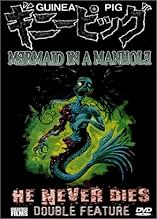Ginî piggu: Manhôru no naka no ningyo
- Vídeo
- 1988
- 1h 3min
PUNTUACIÓN EN IMDb
5,5/10
2,7 mil
TU PUNTUACIÓN
Añade un argumento en tu idiomaAn artist rescues a mermaid in a sewer who develops bleeding sores all over her body, paints a portrait with her oozes and eventually disjoints her.An artist rescues a mermaid in a sewer who develops bleeding sores all over her body, paints a portrait with her oozes and eventually disjoints her.An artist rescues a mermaid in a sewer who develops bleeding sores all over her body, paints a portrait with her oozes and eventually disjoints her.
Reseñas destacadas
It is hard to describe the viewing experience for this movie. Even if you have seen the other Guinea Pig series movies, this one is on another level of disturbing. Where the first three are gory, they are also just straightforward dismemberment stories. They are simple and shocking, but no really new ground from hundreds of other horror movies. Mermaid in a Manhole is a different story. It focuses on disease and decay. It captures the lead character's descent into insanity. Then, once the viewer has gone through all this for the first two-thirds of the movie, we move to the dismemberment.
I like the psychological angle of this story and I think it makes this installment much better than the first two, but it is hard to watch and appreciate. To some degree, it reminds me of Nekromantik in that the story is intriguing and pushes the viewer to think about what is happening, but the images are so terrible that it is hard to want to.
I like the psychological angle of this story and I think it makes this installment much better than the first two, but it is hard to watch and appreciate. To some degree, it reminds me of Nekromantik in that the story is intriguing and pushes the viewer to think about what is happening, but the images are so terrible that it is hard to want to.
This is a rather strange entry in the Guinea Pig franchise but one that is a must see after a while because in the beginning it looks rather childish and stupid but slowly it turns into a squirmfest to end in a gorefest.
When a painter wants to return to a sewer were he has been before entering the manhole to go into the sewer he comes across a girl laying in the filthy water. Coming closer he notices that it is a mermaid. Somehwo he has seen her before but by getting closer he sees that she has some kind of infection. He picks her up and takes her home to place her in a bath. She do ask to be painted by him and to use the colored puss coming out of her infection. Until then it's a bit ridiculous but the painter gets addicted to her and when the infection gets worse and she almost dies the worms come in.
It's from that point that this horror flick turns into a gruesome flick. First out of the puss do come the worms but if that's not enough she starts vomiting worms being alive and it's not faked. Naturally the mermaid do dies and the painter can't take it anymore and starts to cut her up. At the end we do have a twist and this gory flick is over.
It's a rather good entry into the franchise because it do has it flows. The worms can make viewers decide to turn it off but for people into Japanese stuff this is your thing.
Gore 3/5 Nudity 1/5 Effects 3/5 Story 3/5 Comedy 0/5
When a painter wants to return to a sewer were he has been before entering the manhole to go into the sewer he comes across a girl laying in the filthy water. Coming closer he notices that it is a mermaid. Somehwo he has seen her before but by getting closer he sees that she has some kind of infection. He picks her up and takes her home to place her in a bath. She do ask to be painted by him and to use the colored puss coming out of her infection. Until then it's a bit ridiculous but the painter gets addicted to her and when the infection gets worse and she almost dies the worms come in.
It's from that point that this horror flick turns into a gruesome flick. First out of the puss do come the worms but if that's not enough she starts vomiting worms being alive and it's not faked. Naturally the mermaid do dies and the painter can't take it anymore and starts to cut her up. At the end we do have a twist and this gory flick is over.
It's a rather good entry into the franchise because it do has it flows. The worms can make viewers decide to turn it off but for people into Japanese stuff this is your thing.
Gore 3/5 Nudity 1/5 Effects 3/5 Story 3/5 Comedy 0/5
8w00f
Wow.
I have rarely seen a film that manages to be intensely disgusting and poetically beautiful at the same time. Despite the reputation of the Ginipiggu films, this wasn't the most intense gore I've ever seen... Fulci's "Paura nella città dei morti viventi" is more disturbing, if not more graphic, and certainly far more violent. Fulci's film doesn't come close to the visual poetry that "Mermaid" exhibits in places, nor does it delve into the places in the soul that this film did.
Confused yet?
The basic story of "Mermaid": a Japanese artist has a penchant for lurking in a sewer near his home. We find out that this is because a beautiful mermaid lived in the river that once flowed where the sewer now sits. While skulking in the sewer one day, he finds the mermaid. She's been living in the darkness for decades, having become stranded when the city was built. The painter visits her repeatedly, and one day notices a horrible infection beginning on her abdomen. He realizes that she's gotten this infection from being trapped in the sewer for so long, and so he takes her home to care for her and paint her.
The mermaid is the embodiment of the painter's childhood dreams, his innocence, and his joy. The infection is the decay of his own being, his psyche itself. As the film progresses, so does the infection, slowly disfiguring the mermaid until she comes to resemble ground beef covered with tumors that ooze multi-colored pus and occasionally give rise to masses of worms. She won't die, though, until he finishes his painting of her. She does die (which is an obvious outcome from the early part of the film -- but not the *ending*), and she does so slowly, painfully, horribly, and very graphically. If the thought of a boil-covered, bleeding woman lying in a bathtub filled with her own blood (and other fluids) while vomiting up blood and worms seems unpalatable to you, do NOT watch this film. I could easily see some of the scenes inducing a reversal of peristalsis in many viewers. I've seen some intense horror flicks and some very "realistic" gore, but there were definitely some nauseating and difficult moments for me in "Mermaid".
There's also a scene wherein the mermaid has died and we see flowing paint obscure the paintings that the artist has rendered from his childhood memories as he dismembers her body, ostensibly for disposal. If I told any more, though, I'd be giving away the ending... and that wouldn't be fair.
If you've got the stomach for it, I would highly recommend this film. The acting is solid (the dialogue is in Japanese with English subtitles), and the production values are quite good for a straight-to-video effort. This was a top ten seller in Japan for two months when it first came out, and with good reason. In many ways, this is a really excellent film, and it balances loathing and almost Poe-like horror with a certain inner beauty. I'm not generally a big fan of Japanese horror, but I haven't seen anything else that manages such a fine balancing act.
"Mermaid in a Manhole" is available in the US only through Unearthed Films. It's worth the effort and expense to get hold of a copy.
I have rarely seen a film that manages to be intensely disgusting and poetically beautiful at the same time. Despite the reputation of the Ginipiggu films, this wasn't the most intense gore I've ever seen... Fulci's "Paura nella città dei morti viventi" is more disturbing, if not more graphic, and certainly far more violent. Fulci's film doesn't come close to the visual poetry that "Mermaid" exhibits in places, nor does it delve into the places in the soul that this film did.
Confused yet?
The basic story of "Mermaid": a Japanese artist has a penchant for lurking in a sewer near his home. We find out that this is because a beautiful mermaid lived in the river that once flowed where the sewer now sits. While skulking in the sewer one day, he finds the mermaid. She's been living in the darkness for decades, having become stranded when the city was built. The painter visits her repeatedly, and one day notices a horrible infection beginning on her abdomen. He realizes that she's gotten this infection from being trapped in the sewer for so long, and so he takes her home to care for her and paint her.
The mermaid is the embodiment of the painter's childhood dreams, his innocence, and his joy. The infection is the decay of his own being, his psyche itself. As the film progresses, so does the infection, slowly disfiguring the mermaid until she comes to resemble ground beef covered with tumors that ooze multi-colored pus and occasionally give rise to masses of worms. She won't die, though, until he finishes his painting of her. She does die (which is an obvious outcome from the early part of the film -- but not the *ending*), and she does so slowly, painfully, horribly, and very graphically. If the thought of a boil-covered, bleeding woman lying in a bathtub filled with her own blood (and other fluids) while vomiting up blood and worms seems unpalatable to you, do NOT watch this film. I could easily see some of the scenes inducing a reversal of peristalsis in many viewers. I've seen some intense horror flicks and some very "realistic" gore, but there were definitely some nauseating and difficult moments for me in "Mermaid".
There's also a scene wherein the mermaid has died and we see flowing paint obscure the paintings that the artist has rendered from his childhood memories as he dismembers her body, ostensibly for disposal. If I told any more, though, I'd be giving away the ending... and that wouldn't be fair.
If you've got the stomach for it, I would highly recommend this film. The acting is solid (the dialogue is in Japanese with English subtitles), and the production values are quite good for a straight-to-video effort. This was a top ten seller in Japan for two months when it first came out, and with good reason. In many ways, this is a really excellent film, and it balances loathing and almost Poe-like horror with a certain inner beauty. I'm not generally a big fan of Japanese horror, but I haven't seen anything else that manages such a fine balancing act.
"Mermaid in a Manhole" is available in the US only through Unearthed Films. It's worth the effort and expense to get hold of a copy.
Guinea Pig III: Mermaid in a Sewer (Hideshi Hino, 1988)
Mermaid in a Sewer, one of the four Guinea Pig films directed by Hino, is the only one that rivals The Flower of Flesh and Blood in notoriety and popularity. Unlike its more graphic and brutal cousin, Mermaid in a Sewer (often translated as Mermaid in a Manhole, Mermaid in the Bathtub, or any other number of similar titles) actually has a plot to it. An artist (Shigeru Saiki), obviously modeled on Hino himself (Hino's style is unmistakable), draws his inspiration from things he sees and finds in his local sewer system. One day, what he finds among the muck and stench is... a mermaid (Mari Somei). Yes, a mermaid. A very attractive one at that (and one is forced to wonder what, exactly, would motivate an actress to play a part like this...). We find out, after the two have conversed a bit and he's done a preliminary sketch, that she is wounded. He takes her home (how he gets her there without anyone noticing is beyond me) and installs her in his bathtub in order to take care of her.
You can see where this is going, I'm sure. Wound + sewer = bad, bad things.
I'd comment on the acting, dialogue, etc. if I actually understood Japanese. Sometimes watching films in foreign languages with no subtitles is good for the soul, I guess (though anyone who happens to have a script from either 2 or 3 in English who'd be willing to send a copy my way would be remembered in my will, and not with a debt). The couple who lives downstairs from the artist (Masami Hisamoto, Tsuyoshi Toshishige) pop up every now and then to give what would seem a comic turn to the film, which only adds to the disgust and horror. If you get nightmares easily, this is not a film you ever want to see. As Joaquin Phoenix said in what was one of only a handful of lines in _8mm_ that's actually worth remembering, "there are some things you can't un-see." I could never pop this tape into the cassette player again, and certain images would remain as fresh in my mind as they are right now. It's that bad. *** 1/2
Mermaid in a Sewer, one of the four Guinea Pig films directed by Hino, is the only one that rivals The Flower of Flesh and Blood in notoriety and popularity. Unlike its more graphic and brutal cousin, Mermaid in a Sewer (often translated as Mermaid in a Manhole, Mermaid in the Bathtub, or any other number of similar titles) actually has a plot to it. An artist (Shigeru Saiki), obviously modeled on Hino himself (Hino's style is unmistakable), draws his inspiration from things he sees and finds in his local sewer system. One day, what he finds among the muck and stench is... a mermaid (Mari Somei). Yes, a mermaid. A very attractive one at that (and one is forced to wonder what, exactly, would motivate an actress to play a part like this...). We find out, after the two have conversed a bit and he's done a preliminary sketch, that she is wounded. He takes her home (how he gets her there without anyone noticing is beyond me) and installs her in his bathtub in order to take care of her.
You can see where this is going, I'm sure. Wound + sewer = bad, bad things.
I'd comment on the acting, dialogue, etc. if I actually understood Japanese. Sometimes watching films in foreign languages with no subtitles is good for the soul, I guess (though anyone who happens to have a script from either 2 or 3 in English who'd be willing to send a copy my way would be remembered in my will, and not with a debt). The couple who lives downstairs from the artist (Masami Hisamoto, Tsuyoshi Toshishige) pop up every now and then to give what would seem a comic turn to the film, which only adds to the disgust and horror. If you get nightmares easily, this is not a film you ever want to see. As Joaquin Phoenix said in what was one of only a handful of lines in _8mm_ that's actually worth remembering, "there are some things you can't un-see." I could never pop this tape into the cassette player again, and certain images would remain as fresh in my mind as they are right now. It's that bad. *** 1/2
This is a sick movie. A young painter finds a dying mermaid in the sewer and he takes her home. Then the mayhem begins... This is actually a real movie compared to the previous "Guinea Pig"-movies. It´s not so sick an it got a certain cinematic style. Still I wouldn´t recommend it to anyone but hardcore-Japanese-splatter-movie-fans. I give it 5 out of 10.
¿Sabías que...?
- CuriosidadesThis is the last film starring Mari Somei, as the 25-years-old actress mysteriously disappeared in 1988. Her fate remains unknown.
- Créditos adicionalesAt the end of the credits there is a small scene in the sewer where we hear something move in the water.
- ConexionesEdited into Guinea Pig's Greatest Cuts (2005)
Selecciones populares
Inicia sesión para calificar y añadir a tu lista para recibir recomendaciones personalizadas
Detalles
- Fecha de lanzamiento
- País de origen
- Idioma
- Títulos en diferentes países
- Guinea Pig 5: Mermaid in a Manhole
- Empresas productoras
- Ver más compañías en los créditos en IMDbPro
- Duración1 hora 3 minutos
- Color
Contribuir a esta página
Sugerir un cambio o añadir el contenido que falta




















